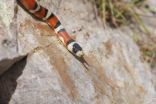(Press-News.org) These new findings were reported by scientists from the German Leibniz Institute for Zoo and Wildlife Research Berlin (IZW). The study – published in the British Ecological Society's Journal of Applied Ecology – is the first to show that seed-dispersing bats avoid feeding in light-polluted areas.
Working in Costa Rica with Sowell's short-tailed bats (Carollia sowelli), Daniel Lewanzik from the IZW gave the bats a simple choice. He divided a flight cage into two compartments. One was naturally dark and the other was illuminated by a sodium street lamp, the most common form of street lighting in the world. Inside both parts of the cage the bats were offered their favourite fruits to harvest: pepper plants, nightshade and figs.
The results revealed that bats flew into the dark compartment twice as often as the compartment lit by a street lamp. The bats also harvested fruits almost twice as often in the dark compartment.
In a second experiment Lewanzik illuminated pepper plants growing in the wild with a street light and measured the percentage of ripe fruit which bats harvested from plants in a dark location and from lit plants. While bats harvested 100 per cent of the marked, ripe fruit from the plants in the dark, only 78 per cent were taken from the lit plants.
Although insect-eating bats have been shown to avoid foraging in light-polluted areas, this is the first study to show that fruit-eating bats also avoid lit areas.
This has important implications for forest regeneration in the tropics. Bats play a key role in pollinating plants and spreading their seeds, especially the seeds of species that are first to recolonise cleared land. "In tropical habitats bat-mediated seed dispersal is necessary for the rapid succession of deforested land because few other animals than bats disperse seeds into open habitats," says Daniel Lewanzik, a PhD student at the IZW and first author of the study.
Under naturally dark conditions, bats produce a copious 'seed rain' when defecating seeds while flying. By reducing foraging of fruit-eating bats in lit areas, light pollution is likely to reduce seed rain.
In many tropical countries, light pollution is increasing rapidly as economies and human populations grow. Natural succession of forests could therefore suffer as tropical habitats become increasingly illuminated. "The impact of light pollution could be reduced by changes in lighting design and by setting up dark refuges connected by dark corridors for light-sensitive species like bats," Lewanzik says.
INFORMATION:
Publication:
Lewanzik D, Voigt CC (2014): Artificial light puts ecosystem services of frugivorous bats at risk. Journal of Applied Ecology. DOI: 10.1111/1365-2664.12206.
Light pollution impairs rainforest regeneration
2014-03-11
ELSE PRESS RELEASES FROM THIS DATE:
Glucosamine fails to prevent deterioration of knee cartilage, decrease pain
2014-03-11
A short-term study found that oral glucosamine supplementation is not associated with a lessening of knee cartilage deterioration among individuals with chronic knee pain. Findings published in Arthritis & Rheumatology, a journal of the American College of Rheumatology (ACR) journal, indicate that glucosamine does not decrease pain or improve knee bone marrow lesions—more commonly known as bone bruises and thought to be a source of pain in those with osteoarthritis (OA).
According to the ACR 27 million Americans over 25 years of age are diagnosed with OA—the most common ...
Speed trap for fish catches domestic trout moving too slow
2014-03-11
PULLMAN, Wash.—Washington State University researchers have documented dramatic differences in the swimming ability of domesticated trout and their wilder relatives. The study calls into question the ability of hatcheries to mitigate more than a century of disturbances to wild fish populations.
Kristy Bellinger, who did the study for her work on a Ph.D. in zoology, said traditional hatcheries commonly breed for large fish at the cost of the speed they need to escape predators in the wild.
"The use of hatcheries to support declining wild salmon and steelhead is controversial," ...
Prescriptions for opioids stabilizing after fivefold increase in 10-year span
2014-03-11
March 10, 2014 -- Death rates from opioids have been soaring in the U.S. since the 1990s. To support the appropriate use of these controlled substances and inform public health interventions to prevent drug abuse, most states have implemented a prescription drug monitoring program (PDMP). In a latest study, researchers at Columbia University's Mailman School of Public Health evaluated the impact of these state-wide programs and found that after tripling until 2007, annual rates of prescriptions for opioid analgesics have stabilized although the effects of PDMPs on opioid ...
Impersonating poisonous prey
2014-03-10
EAST LANSING, Mich. — Imitation is the most sincere form of flattery – especially in the predator/prey/poison cycle.
In nature, bright colors are basically neon signs that scream, "Don't eat me!" But how did prey evolve these characteristics? When did predators translate the meaning?
In the current issue of the journal PLOS ONE, researchers at Michigan State University reveal that these color-coded communiqués evolve over time through gradual steps. Equally interesting, the scientists show how drab-colored, oft-eaten prey adopt garish colors to live long and prosper, ...
Claim that raw milk reduces lactose intolerance doesn't pass smell test, study finds
2014-03-10
STANFORD, Calif. — Some sour news for lactose-intolerant people who hoped that raw milk might prove easier to stomach than pasteurized milk: A pilot study from the Stanford University School of Medicine shows little difference in digestibility between the two.
The study was small — it involved 16 participants — but the lead investigator said the results were highly consistent among all the participants and deflate some of the claims surrounding raw, or unpasteurized, milk.
"It's not that there was a trend toward a benefit from raw milk and our study wasn't big enough ...
Small biomass power plants could help rural economies, stabilize national power grid, MU study finds
2014-03-10
COLUMBIA, Mo. – As energy costs rise, more Americans are turning to bioenergy to provide power to their homes and workplaces. Bioenergy is renewable energy made from organic sources, such as biomass. Technology has advanced enough that biomass power plants small enough to fit on a farm can be built at relatively low costs. Now, University of Missouri researchers have found that creating a bioenergy grid with these small plants could benefit people in rural areas of the country as well as provide relief to an overworked national power grid.
"Transporting power through ...
UV light aids cancer cells that creep along the outside of blood vessels
2014-03-10
A new study by UCLA scientists and colleagues adds further proof to earlier findings by Dr. Claire Lugassy and Dr. Raymond Barnhill of UCLA's Jonsson Comprehensive Cancer Center that deadly melanoma cells can spread through the body by creeping like tiny spiders along the outside of blood vessels without ever entering the bloodstream.
In addition, the new research, published March 6 in the journal Nature, demonstrates that this process is accelerated when the skin cancer cells are exposed to ultraviolet light. The husband-and-wife team of Barnhill and Lugassy collaborated ...
Natural selection has altered the appearance of Europeans over the past 5,000 years
2014-03-10
There has been much research into the factors that have influenced the human genome since the end of the last Ice Age. Anthropologists at Johannes Gutenberg University Mainz (JGU) and geneticists at University College London (UCL), working in collaboration with archaeologists from Berlin and Kiev, have analyzed ancient DNA from skeletons and found that selection has had a significant effect on the human genome even in the past 5,000 years, resulting in sustained changes to the appearance of people. The results of this current research project have been published this week ...
JCI online ahead of print table of contents for March 10, 2014
2014-03-10
Identification of a broadly neutralizing HIV-1 antibody in a lupus patient
Broadly neutralizing antibodies (BnAbs) recognize conserved epitopes, representing a promising strategy for targeting rapidly mutating viruses. BnAbs display a unique set of characteristics that suggest their development may be limited by immune tolerance. Interestingly, the HIV-1 infection frequency is disproportionately low among patients with the autoimmune disease lupus. In this issue of the Journal of Clinical Investigation, Mattia Bonsignori and colleagues at Duke University identified an ...
NASA data shed new light on changing Greenland ice
2014-03-10
Research using NASA data is giving new insight into one of the processes causing Greenland's ice sheet to lose mass. A team of scientists used satellite observations and ice thickness measurements gathered by NASA's Operation IceBridge to calculate the rate at which ice flows through Greenland's glaciers into the ocean. The findings of this research give a clearer picture of how glacier flow affects the Greenland Ice Sheet and shows that this dynamic process is dominated by a small number of glaciers.
Over the past few years, Operation IceBridge measured the thickness ...




